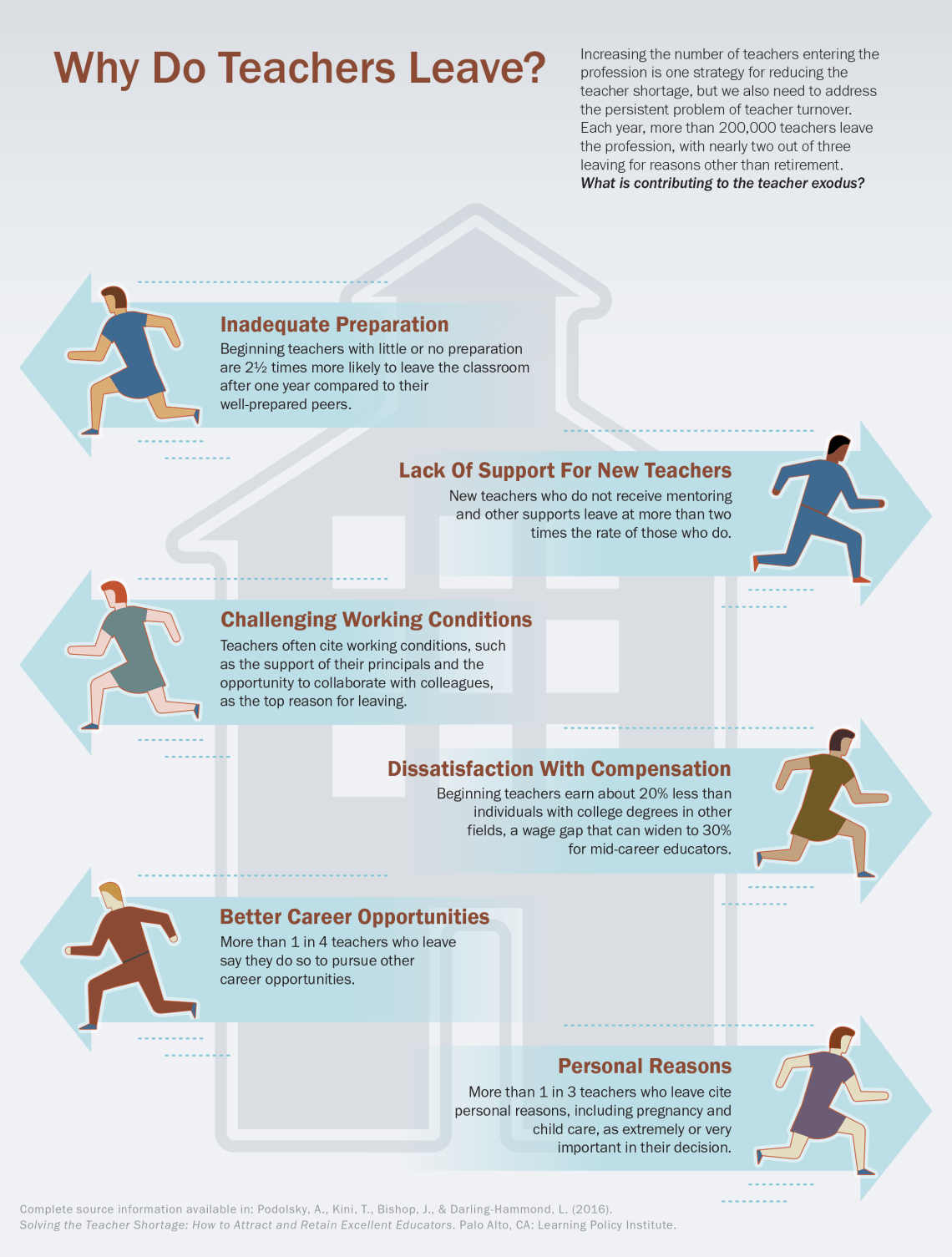Solving the Teacher Shortage: How to Attract and Retain Excellent Educators

One of the most pressing issues facing policymakers is how to staff classrooms with a stable teaching workforce responsive to complex student needs and the growing demands of the knowledge economy. Recurrent teacher shortages are a function of both declines in entrants to teaching and high rates of teacher turnover, especially in low-income schools. This turnover is costly, and undermines student achievement and school improvement efforts. A better understanding of why teachers enter and leave the profession, and what might encourage them to stay or return, is critical to improving the educational opportunities for all students, especially those attending the most disadvantaged schools.
This report reviews an extensive body of research on teacher recruitment and retention, and identifies five major factors that influence a teacher’s decision to enter, remain in, or leave the teaching profession, generally, and high-need schools, specifically. Those factors are: salaries and other compensation; preparation and costs to entry; hiring and personnel management; induction and support for new teachers; and working conditions, including school leadership, professional collaboration and shared decision making, accountability systems, and resources for teaching and learning.
Salaries and Other Compensation
Teachers’ salaries affect the supply of teachers, including the distribution of teachers across districts, and the quality and quantity of individuals preparing to be teachers. Salaries also appear to influence teacher attrition—teachers are more likely to quit when they work in districts with lower wages. Better pay is also what would bring them back to the classroom. Of public school teachers who left the profession in 2012 and said they would consider returning, 67% rated an increase in salary as extremely or very important to their decision to return.
Despite the evidence that salaries influence teacher recruitment and retention, a teacher’s salary in much of the United States is too low to support a middle-class existence. A recent study from the Center for American Progress, for example, found that, in 30 states, mid-career teachers who head families of four or more are eligible for government subsidies, such as subsidized children’s health insurance or free or reduced-price school meals.
Preparation and Costs to Entry
Strong preparation increases teachers’ efficacy and makes it more likely they will remain in the profession. Depending on the study, attrition rates are found to be two to three times higher for teachers who enter the profession without full preparation, than for teachers who are comprehensively prepared.
But the rising costs of higher education—and concern about student loan debt—has contributed to many prospective teachers choosing alternative pathways that allow them to begin teaching and earning a salary, while they are studying to be a teacher. Debt loads can be offset with forgivable loans and scholarships that can boost recruitment and retention. In addition, pathway programs that provide financial aid and support to prospective teachers who already work in schools, often as teachers’ aides or paraprofessionals in hard-to-staff schools, help to recruit teachers who are knowledgeable about the communities in which they will teach.
Hiring and Personnel Management
Research suggests that district and school practices related to hiring and supporting teachers influence teachers’ decisions to enter, remain in, or leave the profession. Based on their review of the research, authors identify the following practices as contributing to the quality of teachers hired, teacher retention rates, and student achievement:
Timing of hiring: The late hiring of teachers negatively affects teacher recruitment, retention, and student achievement.
Information in the hiring process: Schools and districts sometimes engage in weak hiring processes because they have outdated technology, poor capacity to transmit information, and limited time for candidate demonstration lessons.
School and district support for mobile teachers: Of public school teachers who left and said they would consider returning to teaching, more than 40% cited state certification reciprocity as an important factor, and nearly 70% cited the ability to keep retirement benefits. Also cited is the loss of seniority when teachers move to another state or district.
Working Conditions
Teaching conditions—which also define learning conditions for students—are a strong predictor of teachers’ decisions about where to teach and whether to stay. Four factors are consistently cited:
School leadership and administrative support: Administrative support is often the top reason teachers identify for leaving or staying in the profession, or in a given school, outweighing even salary considerations for some teachers.
Opportunities for professional collaboration and shared decision-making: Teachers’ career decisions are shaped by their connectedness to a team working with a shared purpose. Opportunities for teacher collaboration and input are key factors.
Accountability systems: Approximately 25% of public school teachers who left the profession in 2012 reported that dissatisfaction with the influence of school assessment and accountability measures on their teaching or curriculum was extremely or very important in their decision to leave.
Resources for teaching and learning: Schools with sufficient instructional materials and supplies, safe and clean facilities, reasonable student-to-teacher ratios, and adequate support personnel can positively affect teacher retention rates, and influence the kind of teaching and learning that can occur.
Policy Recommendations
Informed by the research, the authors offer the following recommendations for federal, state, and local policymakers:
- Increase teacher salaries in schools and communities where salaries are not competitive or able to support a middle-class lifestyle.
- Use federal levers in the new Every Student Succeeds Act (ESSA) to provide low-income schools and districts with additional resources to attract and retain high-quality teachers.
- Increase teachers’ overall compensation by offering housing incentives.
- Offer career advancement opportunities that provide increased compensation, responsibility, and recognition.
- Provide service scholarships and loan forgiveness programs to attract prospective teachers to the fields and locations where they are needed most.
- Develop teacher residencies.
- Create local pathways into the profession, such as high school career pathways and “Grow Your Own” teacher preparation models.
- Strengthen hiring practices to ensure decisions are made as early as possible with the best candidate pool and based on the best information possible.
- Revise timelines for voluntary transfers or resignations so that hiring processes can take place as early as possible, ideally in the spring of the prior school year.
- Build training and hiring pipelines for new and veteran teachers, while monitoring and reducing teacher turnover and reducing unnecessary barriers to entry for mobile teachers.
- Create cross-state pension portability for teachers.
- Invest in high-quality induction programs.
- Invest in the development of high-quality principals who work to include teachers in decision-making and foster positive school cultures.
- Survey teachers to assess the quality of the teaching and learning environment, and to guide improvements.
- Incentivize professional development strategies and the redesign of schools to provide for greater collaboration.
Conclusion
There is no silver bullet solution to recruiting and retaining a 3-million person teaching workforce serving more than 50 million students across 50 states. Based on their research, authors identify 15 high-leverage policies and strategies (see sidebar) for federal, state, and district officials to consider in order to ensure that teachers lead, rather than leave the profession. They recommend a comprehensive set of policies be enacted, including those tailored to local need and circumstances, to address our emerging teacher shortage and ensure every child is taught by a competent, committed teacher.
Solving the Teacher Shortage: How to Attract and Retain Excellent Educators by Anne Podolsky, Tara Kini, Joseph Bishop, and Linda Darling-Hammond is licensed under a Creative Commons Attribution-NonCommercial 4.0 International License.
Research in this area of work is funded in part by the S. D. Bechtel, Jr. Foundation. Core operating support for the Learning Policy Institute is provided by the Ford Foundation, the William and Flora Hewlett Foundation, and the Sandler Foundation.

